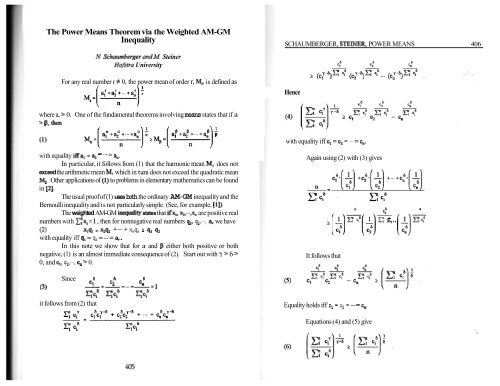The Power Means Theorem via the Weighted AM-GMInequalityN. Schaumberger andM SteinerHofstra UniversityFor any real number r + 0, the power mean of order r, & is defined asSCHAUMBERGER, STEINER, POWER MEANS 406Hencewhere a, > 0. One of the fundamental theorems involving means states that if a> 0, thenwith equality iff c, = c, = - = cn.with equality iffa, = = - =In particular, it follows from (1) that the harmonic mean M-, does notexceed the arithmetic mean Mi which in turn does not exceed the quadratic meanM2. Other applications of (1) to problems in elementary mathematics can be foundin [2],The usual proof of (1) uses both the ordinary AM-GM inequality and theBernoulli inequality and is not particularly simple. (See, for example, [I]).The weighted AM-GM inequahty states that ifx,, x2,-,x,, are positive realnumbers with Exi = 1, then for nonnegative real numbers q,, q,,-, a, we have(2) x1q1 + X A + + Xnqn 2 q1 q2with equality iff q, = q, = --- = a,.In this note we show that for a and P either both positive or bothnegative, (1) is an almost immediate consequence of (2). Start out with y > 6 :0, and c,, c2,-, cn > 0.Since6c; 2 cn(3)+.+.+GC.6 zc.6it follows from (2) thatwAgain using (2) with (3) givesIt follows thatEquality holds iff cl = c, = - = c,,.[d-(2) [Fb 6 6-c2-1 r^f 1 Fi st,..Equations (4) and (5) give
407 PI MU EPSILON JOURNALWrite (6) asIn other wordswith equality iff ci = c, = - = c,,.Toget(l)fora>6>O,use(7)withy=a, 6=p, andci=a;, 1 s i 2 n.Similarly, (1) can be obtained for 0 > a > p by using (7) with y = -p, 6 =1-a, ci = -, 1 0 > p.ThusReferences1. N.D. Kazarinoff, Analytic Inequalities, Holt, Rinehart, and Winston,N.Y., 1961, pp. 62-64.2. P.P. Korovkin, Inequalities, Blaisdell Publishing Co., N.Y., 1961,Ch. 2,3.MISCELLANYChapter ReportsProfessorJoanne Snow reports that the INDIANA EPSILON ~ha~ter(Saint Mary's College) was addressed by Dr. Maura Mast (University of<strong>No</strong>rthern Iowa) at the department's annual Open House. The chapter performedvarious service activities during the year.Professor Chris Leary reports that sixteen talks were presented to theNEW YORK OMEGA Chapter (Saint Bonaventure University) during the 1995-96 academic year. Students P. J. Darcy and David Tascione were members ofSt Bonaventure's team in the Mathematical Contest in Modeling. SIAM selectedthe team's solution to Problem B as the outstanding solution for that problem.Professor Joan Weiss reports that the CONNECTICUT GAMMAChapter (Fairfield University) was addressed by A. Michael White from theDefense Research Agency. The chapter was involved with various mathematicalcontests during the year.ErrataSandra Chandler found die following errors in her paper "Determininga Day of the Week" (<strong>Vol</strong>ume lO(1994-99), Number 4,283-284). In paragraphtwo on page 284, every occurrence of Thursday' should be replaced with'Wednesday'. Also, the last example should read: "Here is a last example toillustrate this: January 6, 1994 was a Thursday; what day will July 4, 1997 fallon? Thursday + 1 + 1 + 2 (now we are at January 6, 1997) + 3 + 0 + 3 + 2 + 3+ 2 (July 6, 1997) - 2 = Thursday + 15 = Friday."Paul S. Bruckman and Robyn M. Carley should have been listed assolvers to Mathacrostic 41.
- Page 2 and 3: - Another Matching Problem with aMa
- Page 4 and 5: Red Light, Green Light:A Model of T
- Page 6 and 7: BENNINK. RED LIGHT, GREEN LIGHT 357
- Page 8 and 9: BENNINK, RED LIGHT, GREEN LIGHT 361
- Page 10 and 11: 365 PI MU EPSILON JOURNALROUSSEAU,
- Page 12 and 13: 369 PI MU EPSILON JOURNALwe havec(n
- Page 14 and 15: 3 73 PI MU EPSILON JOURNALThis can
- Page 16 and 17: VIAR, DIMENSION FORMULA 377subspace
- Page 18 and 19: TOMFORDE, SELF-SIMILARITY 38 1m, n
- Page 20 and 21: TOMFORDE, SELF-SIMILARITY 385Note t
- Page 22 and 23: TOMFORDE, SELF-SIMILARITY 3 896. G.
- Page 24 and 25: 393 PI MU EPSILON JOURNALA Particul
- Page 26 and 27: 397 PI MU EPSILON JOURNALy = ax - b
- Page 28 and 29: 40 1 PI MU EPSILON JOURNALFigure 8P
- Page 32 and 33: MISCELLANY 409The 1995 GameIn die F
- Page 34 and 35: 0. Co-author of convexity theoremP.
- Page 36 and 37: Pi MU EPSILON JOURNALii) JK is para
- Page 38 and 39: PROBLEMS AND SOLUTIONS 42 1Henry S.
- Page 40 and 41: PROBLEMS AND SOLUTIONS 425865. [Fal
- Page 42 and 43: PROBLEMS AND SOLUTIONS 429868. [Fal
- Page 44 and 45: BENNINK, RED LIGHT, GREEN LIGHT 3 6
- Page 46 and 47: PROBLEMS AND SOLUTIONS 437Solution
- Page 48 and 49: Editor's NoteThe Pi Mu Epsilon Jour
















